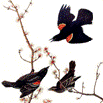Wildlife Damage Management, Internet Center for
Document Type
Article
Date of this Version
September 1968
Abstract
Seven primary factors. The difficulties associated with the control of birds in an orchard are usually related or confounded by four primary, unknown factors and three which are usually quite well known. The four unknowns are: 1. The species causing the damage. 2. The total bird population in the area. 3. The alternate food sources available for the birds. 4. The relative economic importance of the crop to the community in which it is produced. The three known factors which are usually evident: 1. The crop being damaged. 2. The economic importance of the crop to the grower. 3. The prevailing attitudes of the agricultural and non-agricultural resi dents of the community. These are like the primary flight feathers of a bird—the number of these primaries may vary, not necessarily with species, season, sex or age-but rather basically, with geographic distribution. They are, in any given geographic locality, the Seven Horns of a Dilemma, which confront the fruit grower with a bird problem. The seven divided. Perhaps the term "multiplied" would be more appro-priate, but it does not serve to make poignant the fractures which may occur in each factor to confound a practical solution to the problem of orchard bird control. The development of a practical control is dependent upon the proper evaluation of all factors. A failure in the proper functioning of the primary feathers may be disastrous to the bird; and failure to properly evaluate the factors associated with bird control might well result in disastrous consequences for the grower, the community at large, and an endangered species. However, as we recognize that man may cause an evolutionary development to the detriment of a species, let us not forget that he is an integral part of that change and that he can and probably does cause the development of an endangering species.


